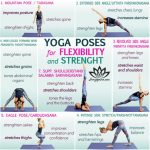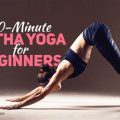Discovering the Best Yoga Practice for Your Body Type: A Tailored Approach
Yoga is a deeply transformative practice, but did you know that choosing the right type of yoga for your body type can maximize its benefits? Just like any physical activity, your body’s natural shape and structure can influence how you experience yoga. Whether you’re an ectomorph, mesomorph, or endomorph, this guide will help you discover which yoga practice best suits your unique body type. By understanding your body’s needs, you can tailor your practice to improve flexibility, strength, and mental clarity.
Introduction
Yoga is a versatile practice that serves different goals—whether it’s increasing flexibility, building strength, reducing stress, or enhancing overall well-being. However, yoga isn’t a one-size-fits-all activity. Your body type plays a significant role in determining which style of yoga will work best for you. The idea that body types should inform yoga practice is rooted in both ancient Ayurvedic principles and modern fitness science.
In this article, we explore how ectomorphs, mesomorphs, and endomorphs—the three primary body types—respond differently to various styles of yoga. We’ll cover the historical background of these body classifications, their application to contemporary yoga, and offer practical tips for selecting the ideal practice. You’ll also find case studies, examples, and expert opinions to guide you on your personalized yoga journey.
Key Concepts
Before diving into how body types influence yoga choices, it’s crucial to understand some key concepts:
- Body Type Classification: The three somatotypes—ectomorph, mesomorph, and endomorph—were first identified by psychologist William Sheldon in the 1940s. Each type has distinct physical traits that affect how the body responds to exercise.
- Ectomorph: These individuals are typically lean, with long limbs and little body fat. They may find it harder to gain muscle and need more strength-building exercises in their yoga routines.
- Mesomorph: Naturally muscular and athletic, mesomorphs excel in physical activities and tend to respond quickly to exercise. They benefit from a balanced yoga practice that incorporates both strength and flexibility.
- Endomorph: Endomorphs have a higher tendency to store fat and often possess a rounder body shape. Yoga styles that emphasize cardiovascular conditioning and flexibility are ideal for them.
By matching your yoga practice to your somatotype, you can enhance your physical and mental outcomes more effectively.
Historical Context
Body typing can be traced back to ancient systems of medicine like Ayurveda, which divided individuals into three doshas—Vata, Pitta, and Kapha. These doshas are related to one’s physical, mental, and emotional attributes, and Ayurvedic practitioners believe that balancing your dosha helps promote optimal health.
Over time, Western scientific theories, including Sheldon’s somatotypes, provided a more anatomy-focused way to classify body types. In both cases, the idea is that not all bodies are the same, and different types need tailored approaches to exercise, diet, and mental health.
Historically, yogic traditions also supported the idea of personalized practice. In ancient India, yoga was often customized to suit the practitioner’s body, mental state, and health needs. Over the centuries, this individualized approach has resurfaced in modern yoga practices, especially with the rise of therapeutic yoga.
Current State Analysis
Today, yoga is more accessible than ever, and the variety of styles—ranging from Hatha to Vinyasa to Bikram—provides ample options for practitioners. However, few people consider how their body type might influence their ability to execute and benefit from certain postures.
For example, ectomorphs may struggle with balance in standing poses due to their long limbs and lower muscle mass, while mesomorphs might excel in strength-based poses but need to focus on improving flexibility. Endomorphs, on the other hand, might find faster-paced styles like Vinyasa challenging but thrive in more restorative practices that improve mobility.
Although the fitness industry increasingly promotes body-type awareness in strength training and cardio routines, yoga has been slower to adopt this approach. Understanding how your somatotype influences your experience on the mat can help you make informed decisions about your practice.
Practical Applications
Here’s how each body type can optimize their yoga practice:
- Ectomorph: Focus on strength-building yoga styles like Ashtanga or Vinyasa Flow to enhance muscle tone. Try poses like Chaturanga Dandasana (Four-Limbed Staff Pose) to build upper body strength and Virabhadrasana II (Warrior II) to stabilize lower-body strength.
- Mesomorph: A balanced practice that includes flexibility work will benefit mesomorphs. Yin Yoga, which holds poses for longer periods, can improve muscle elasticity. Strength poses like Utkatasana (Chair Pose) will allow them to leverage their natural muscularity.
- Endomorph: Styles like Hatha or Restorative Yoga can help endomorphs build flexibility and stamina at a manageable pace. Focus on heart-opening poses like Setu Bandhasana (Bridge Pose) and hip openers like Malasana (Garland Pose) to improve mobility.
Case Studies
| Body Type | Yoga Style | Specific Example | Outcome |
|---|---|---|---|
| Ectomorph | Ashtanga Yoga | Incorporating Utkatasana (Chair Pose) for strength | Improved muscle tone and stamina |
| Mesomorph | Yin Yoga | Holding Baddha Konasana (Butterfly Pose) for deep flexibility | Increased range of motion |
| Endomorph | Restorative Yoga | Using props for Savasana (Corpse Pose) to relax fully | Improved relaxation and stress relief |
Stakeholder Analysis
The different stakeholders in this tailored approach to yoga include:
- Yoga Practitioners: Can benefit from a personalized approach that enhances results and minimizes injury.
- Yoga Instructors: Gain the ability to better serve their students by understanding the impact of body type on practice.
- Fitness Experts: May collaborate with yoga instructors to create cross-disciplinary programs that account for individual physical characteristics.
- Health Professionals: Can recommend specific yoga practices as part of a holistic treatment for body-type-related issues.
Implementation Guidelines
To implement a yoga practice that aligns with your body type:
- Identify your body type—ectomorph, mesomorph, or endomorph—using a fitness assessment or body type calculator.
- Research yoga styles that align with your body type, focusing on both your strengths and areas that need improvement.
- Start with a beginner-friendly class to understand how your body responds to different poses.
- Modify poses as needed using props or alternative forms to accommodate limitations.
- Set realistic goals based on your body type, such as building strength, enhancing flexibility, or improving cardiovascular endurance.
Ethical Considerations
While it’s important to tailor yoga to body types, it’s equally crucial to avoid reinforcing harmful stereotypes about body shape and capability. Every body is capable of improvement through yoga, and instructors must emphasize inclusivity, ensuring that all participants feel welcomed regardless of their physical attributes.
Additionally, practitioners should be aware that yoga’s primary purpose is to unite body and mind. While matching practice to body type can enhance results, the spiritual and mental benefits should not be overshadowed by physical goals alone.
Limitations and Future Research
Although body type provides a helpful framework for tailoring yoga practices, it’s not the sole determinant of how a person will respond to yoga. Factors such as age, injuries, and lifestyle also play significant roles. Future research might explore the interaction between body types and specific health conditions, such as arthritis or cardiovascular diseases, to provide more comprehensive guidance.
Moreover, more research is needed on how body types evolve over time and how this might affect long-term yoga practice. As the practice of yoga continues to grow globally, integrating body-type theory with personalized yoga practices may become more sophisticated, offering practitioners even more tailored solutions.
Expert Commentary
Experts agree that matching yoga practices to body types can be an effective way to maximize physical and mental benefits. Dr. Tara Harding, a sports scientist, notes that “understanding your body’s limitations and strengths allows you to push yourself in a way that’s sustainable and injury-free.”
Meanwhile, yoga instructor Maya Patel adds, “Personalized yoga isn’t about comparison. It’s about growth—at your own pace and in your own way.” By aligning your practice with your body type, you enhance the holistic experience of yoga, unlocking not just physical strength, but also mental clarity and spiritual fulfillment.








